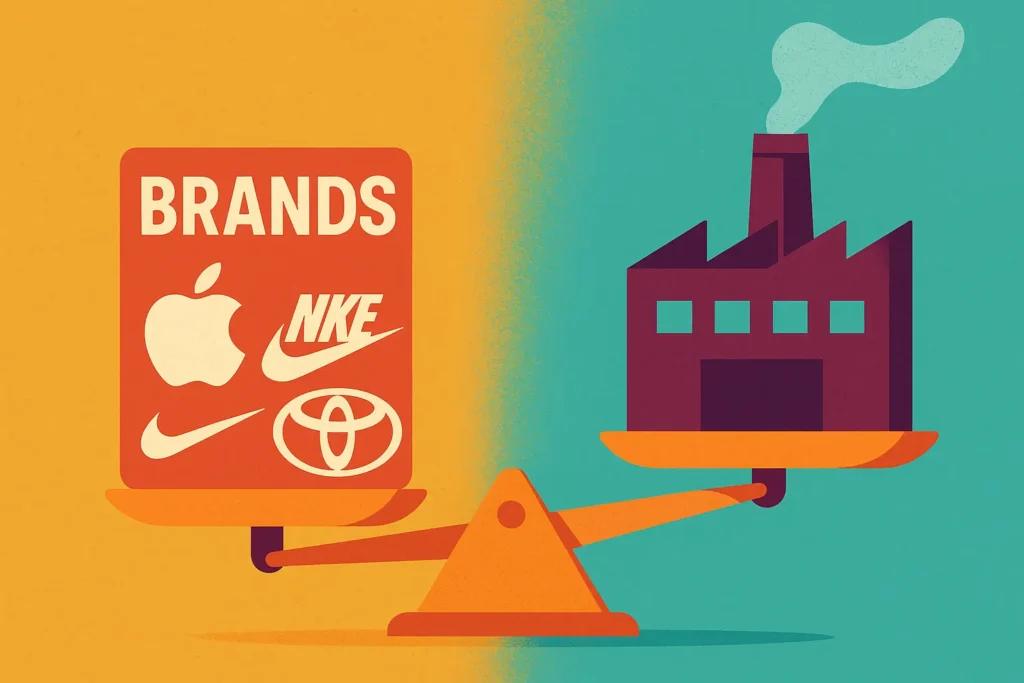[Reading level: B2 – Upper Intermediate]
Apple, Toyota, and Nike—three giants from three different fields—have something in common beyond their global recognition: none of them rely on a single supplier for critical components or manufacturing. Apple works with Foxconn, Pegatron, and Wistron for iPhone assembly. Toyota sources parts from Denso, Aisin, and numerous smaller component makers. Nike collaborates with a global network of contract factories across Vietnam, Indonesia, and China. Despite the convenience and cost-efficiency a single supplier might offer, these companies consciously avoid “putting all their eggs in one basket.” Why? The answer is simple: risk management.
Relying on a sole supplier creates a dangerous single point of failure. If that supplier encounters production delays, natural disasters, labor strikes, political unrest, or quality issues, the entire supply chain can grind to a halt. For global brands that depend on steady product flow and tight delivery schedules, even a few days of disruption can result in massive financial losses, missed market opportunities, and damaged customer trust.
A well-known example is the 2011 earthquake and tsunami in Japan, which disrupted the supply of automotive parts and semiconductors. Companies that depended heavily on Japanese suppliers faced major delays, while those with diversified sourcing were able to bounce back more quickly. Similarly, during the COVID-19 pandemic, brands with flexible, multi-supplier networks adapted better to lockdowns and border closures than those with more rigid, centralized systems.
Another reason large brands avoid sole suppliers is leverage. When a company has only one source, the balance of power tilts toward the supplier. They can dictate pricing, terms, and schedules. By contrast, having multiple suppliers creates competitive pressure, giving the brand more negotiating power and better options if things go wrong.

Finally, multiple suppliers encourage innovation. Different suppliers bring different strengths, technologies, and manufacturing techniques. When brands work with a network of partners, they can test new materials, adopt newer technologies, and scale faster—without being tied to one supplier’s capabilities.
In short, while a sole supplier might offer simplicity, it comes at the cost of flexibility, resilience, and control. That’s why the world’s largest brands always hedge their bets. Redundancy in supply chains isn’t wasteful—it’s strategic.
WORD BANK:
have something in common (phrase): có điểm chung
assembly /əˈsem.bli/ (n): lắp ráp
source sth from sb/sth /sɔːrs frʌm/ (v): lấy nguồn từ ai/cái gì
collaborate with sb/sth /kəˈlæb.ə.reɪt/ [B2] (v): hợp tác với ai/cái gì
contract factory /ˈkɑːn.trækt ˈfæk.tɚ.i/ (n): nhà máy gia công
consciously /ˈkɑːn.ʃəs.li/ [B2] (adv): cố ý
put all their eggs in one basket (idiom): bỏ tất cả trứng vào một giỏ
encounter sth /ɪnˈkaʊn.tɚ/ [B2] (v): gặp phải điều gì
delay /dɪˈleɪ/ [B1] (n): sự chậm trễ
labor strike /ˈleɪ.bɚ straɪk/ (n): đình công
political unrest /pəˈlɪt̬.ɪ.kəl ʌnˈrest/ [C1] (n): bất ổn chính trị
grind to a halt /ɡraɪnd tuː ə hɔːlt/ [C1] (idiom): dừng hoàn toàn
flow /floʊ/ [B2] (n): dòng chảy
tight /taɪt/ [B1] (adj): chặt chẽ
delivery schedule /dɪˈlɪv.ɚ.i ˈʃedʒ.uːl/ (n): lịch trình giao hàng
disrupt sth /dɪsˈrʌpt/ [B2] (v): làm gián đoạn cái gì
automotive /ˌɑː.t̬əˈmoʊ.t̬ɪv/ (adj): ô tô
semiconductor /ˈsem.i.kənˌdʌk.tɚ/ (n): chất bán dẫn
diversified /dɪˈvɝː.sə.faɪd/ [C1] (adj): đa dạng
bounce back /baʊns bæk/ [C1] (phr. v): phục hồi
adapt to sth /əˈdæpt tuː/ [B2] (v): thích ứng với cái gì
lockdown /ˈlɑːk.daʊn/ (n): lệnh phong tỏa
border closure /ˈbɔːr.dɚ ˈkloʊ.ʒɚ/ (n): đóng cửa biên giới
rigid /ˈrɪdʒ.ɪd/ [C1] (adj): cứng nhắc
centralized /ˈsen.trə.laɪzd/ [C1] (adj): tập trung
leverage /ˈlev.ɚ.ɪdʒ/ [C1] (n): cán cân quyền lực
the balance of power /ðə ˈbæl.əns əv ˈpaʊ.ɚ/ [C1] (n): cán cân quyền lực
tilts toward /tɪlts təˈwɔːrd/ [C1] (v): nghiêng về phía nào đó
dictate sth /ˈdɪk.teɪt/ [C1] (v): áp đặt cái gì
terms /tɝːmz/ [B2] (n): điều khoản
negotiating power /nəˈɡoʊ.ʃi.eɪ.t̬ɪŋ ˈpaʊ.ɚ/ [C1] (n): khả năng đàm phán
innovation /ˌɪn.əˈveɪ.ʃən/ [B2] (n): đổi mới
tied to sth /taɪd tuː/ [C1] (adj): ràng buộc vào cái gì
at the cost of sth /æt ðə kɑːst əv/ [C1] (idiom): đổi lại là mất cái gì, cái giá phải trả là cái gì
resilience /rɪˈzɪl.jəns/ [C1] (n): khả năng phục hồi
hedge one’s bets /hedʒ wʌnz bets/ [C1] (idiom): phân tán rủi ro
redundancy /rɪˈdʌn.dən.si/ [C1] (n): sự dư thừa
strategic /strəˈtiː.dʒɪk/ [B2] (adj): mang tính chiến lược
ỦNG HỘ READ TO LEAD!
Chào bạn! Có thể bạn chưa biết, Read to Lead là một trang giáo dục phi lợi nhuận với mục đích góp phần phát triển cộng đồng người học tiếng Anh tại Việt Nam. Chúng tôi không yêu cầu người đọc phải trả bất kỳ chi phí nào để sử dụng các sản phẩm của mình để mọi người đều có cơ hội học tập tốt hơn. Tuy nhiên, nếu bạn có thể, chúng tôi mong nhận được sự hỗ trợ tài chính từ bạn để duy trì hoạt động của trang và phát triển các sản phẩm mới.
Bạn có thể ủng hộ chúng tôi qua 1 trong 2 cách dưới đây.
– Cách 1: Chuyển tiền qua tài khoản Momo.
Số điện thoại 0947.886.865 (Chủ tài khoản: Nguyễn Tiến Trung)
Nội dung chuyển tiền: Ủng hộ Read to Lead
hoặc
– Cách 2: Chuyển tiền qua tài khoản ngân hàng.
Ngân hàng VIB chi nhánh Hải Phòng
Số tài khoản: 012704060048394 (Chủ tài khoản: Nguyễn Tiến Trung)
Nội dung chuyển tiền: Ủng hộ Read to Lead
Lớp luyện thi IELTS online
Bạn đang có nhu cầu thi chứng chỉ IELTS cho đầu vào đại học, đi du học, xin việc hay xin cư trú và đang phân vân chưa biết học ở đâu?
Nếu bạn đang tìm kiếm dịch vụ luyện thi IELTS online với giáo viên uy tín và chất lượng, cũng như học phí phải chăng, thì thầy Trung và Cô Thủy (Admin và dịch giả chính của Read to Lead) có thể là một lựa chọn phù hợp dành cho bạn.
Hãy liên hệ (nhắn tin) tới trang Facebook cá nhân của mình (https://www.facebook.com/nguyen.trung.509) để tìm hiểu về lớp học và được tư vấn cũng như được học thử nha!





